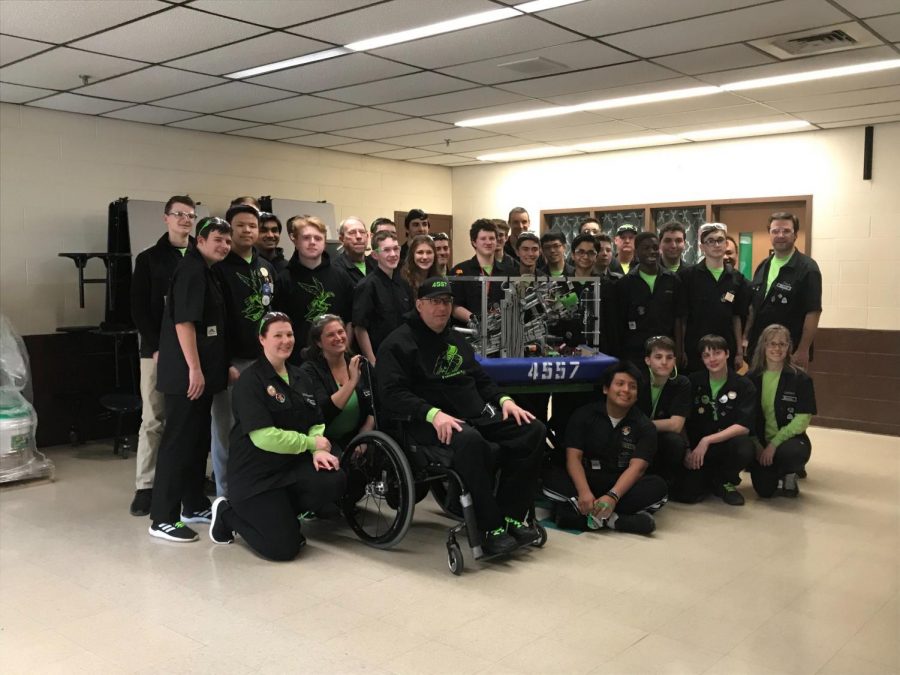A Little Information on Xavier Robotics (No, They Are Not Battle Bots)
October 15, 2020
They are not battle bots. Ok, now that I have that out of the way, we can begin the article. The Xavier robotics team has been building robots for the last few years, consistently doing well in competitions, especially last year. The FRC team only managed to participate in one event, but they got 4th out of 36 teams. Fortunately for the FTC team, they managed to get in three competitions, placing 7th, 6th, and 1st. Well, let me slow down a bit before I get ahead of myself. FTC and FRC are two of the four types of robotics competitions that FIRST offers. Oh wait, I should probably talk about FIRST first (sorry for the pun).
For Inspiration and Recognition of Science and Technology, or as known by its acronym, FIRST, is an organization that allows students to become involved with science, technology, engineering, and mathematics (STEM). Every year since 1989, FIRST has sponsored robotics competitions all around the world, each time forcing the competing teams to design a different robot suited for that year’s unique challenge. Over time, FIRST has developed four levels of competition: FLL Jr., FLL, FTC, and FRC.
FLL Jr., or FIRST LEGO League Jr., is for younger children, introducing them to STEM and robotics through the use of legos. Its older counterpart, FLL, FIRST LEGO League, is for children slightly older than those who participate in FLL jr. Typically, the participants are of middle school age and coached by high schoolers. In fact, many members of Xavier’s robotics team actually coach FLL teams by teaching them certain concepts, helping them code, and just overall preparing them for competitions. These competitions allow for FLL Jr. and FLL teams to learn the basics of robotics through EV3s, the control center of lego robots, and Mindstorm and WeDo, the softwares used to program the lego bots. Overall, FLL Jr. and FLL are great ways of bringing younger students into the world of robotics, preparing them for the more sophisticated challenges of FTC and FRC
As promised, it is time to talk about FTC and FRC. The FIRST Tech Challenge (FTC) is a design-based game intended for high-school students. Every year FIRST gives FTC teams a new challenge to complete, and for the 2020-2021 season, the game is Ultimate Goal, and I will explain it later. Currently, Xavier has two FTC teams, 15668, the FullMetal Kestrels, and 17703, the FullMetal Peregrines. In addition to their two FTC teams, Xavier has one FRC team, team 4557, the FullMetal Falcons. FRC, FIRST Robotics Challenge, is the most advanced game that FIRST offers. While it varies largely in the complexity of the robots and the competitions themselves, a key difference between FTC and FRC is the size of the robots. A FTC robot must be smaller than 18″x18″x18″, while FRC’s size constraint is 33″x28″x55″. This year’s game is a reboot of last year’s game, Infinite Recharge, which was abruptly ended due to the pandemic. Infinite Recharge is a game where robots must shoot goals, climb to a swinging balance, and spin the “wheel of fortune,” a color-wheel that, if spun correctly, awards points to the robot. However, participation in Infinite Recharge is still up in the air, and team 4557 has not yet decided if they will compete in the FRC competitions this year, so I will primarily focus on Ultimate Goal. Well, now that you have a basic understanding of the different types of robotics competitions, I must move onto my next goal of explaining the game Ultimate Goal.
Ultimate Goal consists of multiple two-minute and thirty-seconds matches in which the competing robots will have to complete different tasks in exchange for points. However, there is no fun in just doing a task, and FTC recognizes that. In FRC and FTC, it is not just about completing one task before moving onto the next; rather, it is a point-based game where the drivers of the robot can decide what to do, based on strategy and their robot’s capabilities. Every match is broken up into three parts: (1) autonomous, a thirty-second period where the robot must move on its own without human intervention; (2) teleop, a minute and a half in which the drivers can control their robot; and (3) endgame, the final thirty-seconds of the game that forces the robot to complete the last of their tasks before the match ends. Each period allows for unique challenges, and it is up to the programmers, builders, and drivers to ensure that the robot can perform those tasks successfully. Some of these challenges include picking up small discs and then shooting them into different goals, using color recognition to identify certain locations that the robot must travel to by itself, moving a bowling pin-like object, and knocking over targets from a distance.
Overall, Xavier is very lucky to be a part of the FIRST community. The robotics team has consistently tried to spread STEM and kindness by hosting fundraisers, collecting donations, and hosting camps to help educate others. Xavier participates in FLL Jr., FLL, FTC, and FRC, the four categories of FIRST robotics. Xavier students mentor FLL Jr. and FLL teams, teaching them the basics of STEM. At a high school level, Xavier students compete in FTC and FRC, using the knowledge they have acquired over the years to help them solve the challenges that accompany competing in FIRST competitions. This year, the FTC game is Ultimate Goal, and the FRC game is a reboot of last year’s game, Infinite Recharge. Currently, Xavier only plans on competing in Ultimate Goal. With luck, their season will be largely unaffected by the pandemic, but only time will tell. Well, I hope you now have a firm understanding of the robotics team and how they do not make battle bots.


